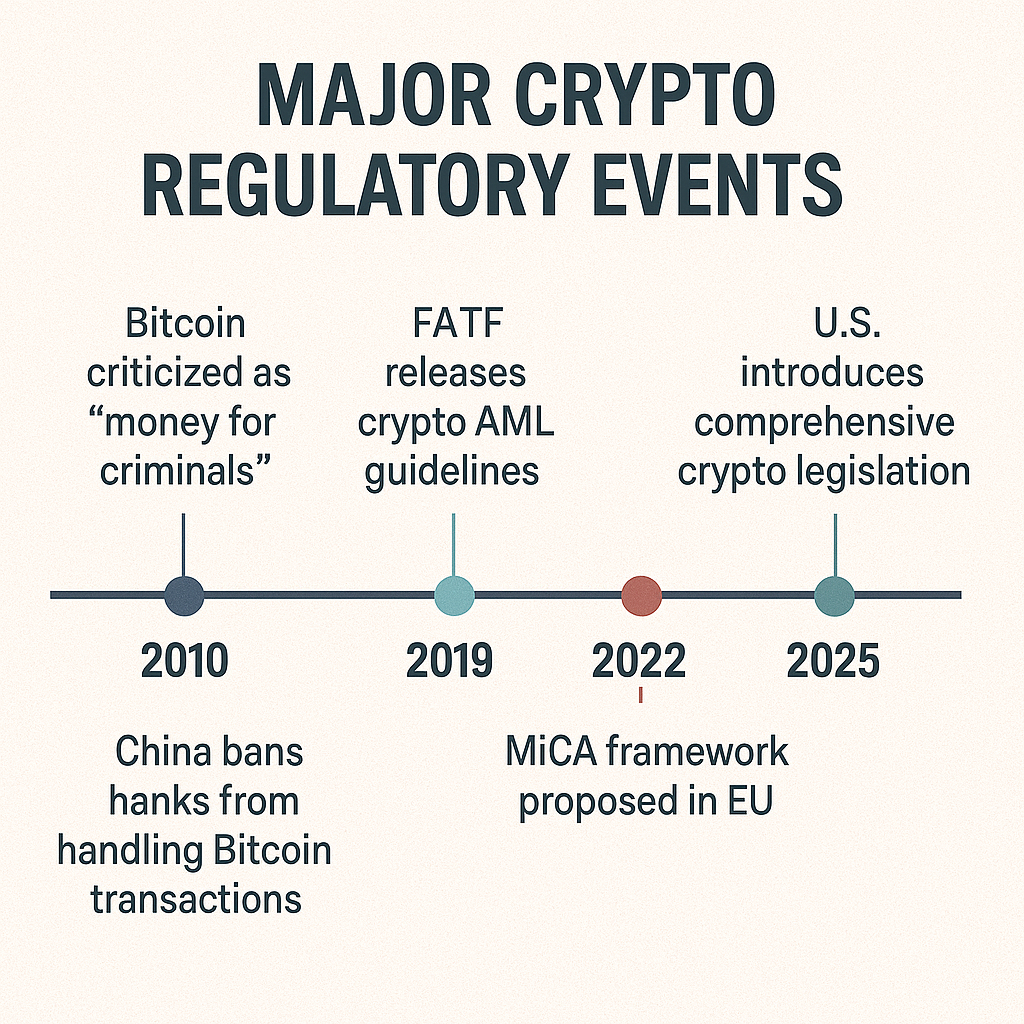By: Michael Moats
In the past decade, cryptocurrencies have evolved from fringe technological experiments to mainstream financial assets, igniting both excitement and controversy across the globe. As Bitcoin, Ethereum, and thousands of other digital currencies surged in value and popularity, governments worldwide have found themselves racing to catch up. The result: a patchwork of regulatory approaches that range from outright bans to state-sponsored digital currencies known as Central Bank Digital Currencies (CBDCs).
This article surveys the global regulatory landscape of digital assets, examining why governments are cracking down, the rise of CBDCs, and what this evolving landscape means for investors navigating an uncertain future.
The Global Regulatory Landscape
Crypto Bans and Restrictions
The global approach to cryptocurrency regulation is far from uniform. In some countries, crypto is embraced as an innovative financial tool; in others, it is viewed as a threat to financial stability and state control.
China, for instance, has taken one of the most hardline stances. Since 2021, the Chinese government has banned all forms of cryptocurrency trading and mining, citing concerns about capital flight, energy consumption, and financial risk. Exchanges and miners have been forced to shut down operations, with enforcement often swift and uncompromising.
India presents a more nuanced case. The Indian government has oscillated between severe restrictions and cautious regulation. In 2022, India imposed a 30% tax on crypto gains and a 1% tax deducted at source (TDS) on transactions. While this did not amount to an outright ban, the heavy tax burden has dampened retail enthusiasm.
Nigeria, Africa’s largest economy, banned banks from servicing crypto businesses in 2021. However, this move paradoxically fueled the growth of peer-to-peer (P2P) trading, demonstrating how regulatory attempts to control digital assets often lead to unintended consequences.
Countries Embracing Regulation
In contrast, several jurisdictions are taking a more measured approach. The European Union has spearheaded the Markets in Crypto-Assets (MiCA) framework, aiming to harmonize crypto regulations across its member states. This comprehensive policy seeks to protect investors, ensure market integrity, and support innovation.
The United States remains a regulatory patchwork. The Securities and Exchange Commission (SEC) and the Commodity Futures Trading Commission (CFTC) vie for jurisdiction over crypto markets, leading to legal ambiguities. High-profile enforcement actions, such as those against Ripple and Coinbase, illustrate the aggressive stance of U.S. regulators, yet a comprehensive federal framework remains elusive.
Japan and South Korea have implemented licensing regimes for exchanges, emphasizing anti-money laundering (AML) compliance and customer protection. Their pragmatic approaches have fostered relatively stable and compliant crypto markets.

The Rise of Central Bank Digital Currencies (CBDCs)
Why Governments Love CBDCs
As governments tighten their grip on cryptocurrencies, many are simultaneously developing their own digital currencies—CBDCs. Unlike decentralized cryptocurrencies, CBDCs are issued and controlled by central banks, offering governments the benefits of digital assets without the volatility and perceived lawlessness.
CBDCs promise:
- Sovereign control over monetary policy.
- Enhanced financial inclusion.
- Greater efficiency in cross-border payments.
- Improved tools for combating illicit financial activities.
Global CBDC Initiatives
China leads the pack with its Digital Yuan (e-CNY), piloted in dozens of cities and integrated into major e-commerce platforms. The European Central Bank is exploring the Digital Euro, focusing on privacy safeguards and seamless cross-border payments. The United States, while still in the research phase, is debating the implications of a Digital Dollar, weighing innovation against privacy and surveillance concerns.
CBDCs vs. Cryptocurrencies
While CBDCs may resemble cryptocurrencies in form, they differ fundamentally in function:
- Control: CBDCs are centralized; cryptocurrencies are decentralized.
- Privacy: CBDCs could enable government surveillance; cryptocurrencies often promise pseudonymity.
- Interoperability: CBDCs may not easily interact with existing crypto ecosystems.
This tension between state control and decentralized freedom lies at the heart of the regulatory debate.

Why Are Governments Cracking Down?
Governments are motivated by a range of concerns when regulating cryptocurrencies:
- Anti-Money Laundering (AML) and Counter-Terrorism Financing (CTF): The pseudonymous nature of crypto transactions raises fears of illicit use.
- Taxation: Ensuring that crypto gains are reported and taxed is a top priority for revenue-hungry governments.
- Consumer Protection: The volatility of digital assets and the proliferation of scams pose risks to unsophisticated investors.
- National Security: Uncontrolled crypto markets can facilitate capital flight and economic destabilization.
Case Studies
The 2022 collapse of FTX sent shockwaves through global markets, highlighting the systemic risks posed by unregulated exchanges. Similarly, the failure of the Terra-LUNA ecosystem underscored the fragility of algorithmic stablecoins. These events have galvanized regulators to act more decisively.
Major exchanges like Binance have faced regulatory hurdles across multiple jurisdictions, demonstrating the challenges of operating in a fragmented global market.

Implications for Investors
For investors, the regulatory crackdown has profound implications:
- Increased Compliance Costs: Exchanges and platforms must invest in KYC/AML procedures, often passing these costs onto users.
- Restricted Access: Certain coins or services may be delisted in jurisdictions with stricter laws.
- Market Fragmentation: Investors may face difficulties moving assets across borders.
Despite these challenges, the industry is adapting. The rise of regulated crypto ETFs and the growing focus on decentralized finance (DeFi) tools and privacy-enhancing technologies signal a maturing market.
Investors seeking exposure to digital assets must stay informed, diversify their holdings, and understand the specific regulatory landscape of their home countries.
The Future of Crypto Regulation
Toward a Global Framework?
There are increasing calls for international cooperation. Organizations like the Financial Action Task Force (FATF) and the International Monetary Fund (IMF) advocate for standardized rules to combat money laundering and protect consumers.
However, national interests often diverge, leading to a fragmented global regulatory environment. The risk of a “crypto cold war” between CBDC-dominant nations (e.g., China, EU) and crypto-friendly zones (e.g., El Salvador, certain U.S. states) looms large.

What Comes Next?
Expect continued innovation in privacy-preserving technologies, such as zero-knowledge proofs and multi-party computation wallets. Meanwhile, the utility of blockchain technology in real-world applications—from supply chain management to digital identity systems—will keep the sector relevant, even as speculative mania cools.
For investors, the message is clear: stay agile, stay informed, and understand that the regulatory landscape is a dynamic, evolving frontier.
It will pan out, eventually
The cryptocurrency crackdown is not the death knell for digital assets but a pivotal moment in their evolution. As governments assert control, investors and innovators alike must adapt. The future of money is digital, but its shape will depend on the delicate dance between freedom and regulation, innovation and oversight.
The world is watching—and the stakes have never been higher.
Suggested Sources for the Article
- World Economic Forum (WEF)
Reports and insights on global financial trends, including CBDC developments
https://www.weforum.org - International Monetary Fund (IMF)
Global policy frameworks, CBDC studies, and crypto regulation perspectives
https://www.imf.org - Financial Action Task Force (FATF)
Guidelines on anti-money laundering (AML) and crypto asset regulation
https://www.fatf-gafi.org - Bank for International Settlements (BIS)
Research papers on CBDCs and global financial stability
https://www.bis.org - European Central Bank (ECB)
Digital Euro project updates and CBDC policy papers
https://www.ecb.europa.eu - U.S. Securities and Exchange Commission (SEC)
Enforcement actions and official statements on crypto regulation
https://www.sec.gov - Commodity Futures Trading Commission (CFTC)
Crypto asset oversight and legal actions in the U.S.
https://www.cftc.gov - People’s Bank of China (PBOC)
Official releases on the Digital Yuan and China’s crypto policy
http://www.pbc.gov.cn - Reuters, Bloomberg, CoinDesk, and The Block
For breaking news and up-to-date information on crypto regulation and market trends
https://www.reuters.com
https://www.bloomberg.com
https://www.coindesk.com
https://www.theblock.co



One thought on “When will Governments Stop the Cryptocurrency Crackdown”